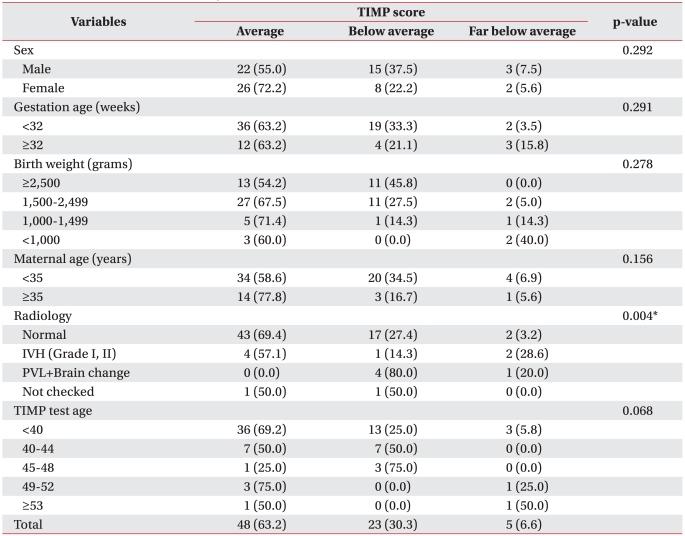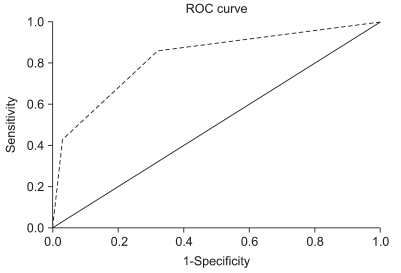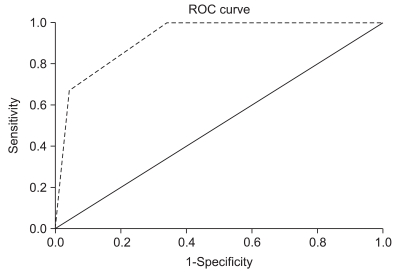Abstract
Objective
To assess the relationship of scores on the test of infant motor performance (TIMP), with those on the Bayley scales of infant development (BSID), and to investigate the sensitivity and specificity of TIMP and the optimal cut-off value of TIMP scores using ROC analysis.
Method
Seventy-six preterm and term infants were recruited from neonatal intensive care units. Subjects were tested with the TIMP at their initial visit and after 6 months, they were tested by using BSID.
Results
In the reliability study, TIMP scores showed highly significant correlation with the Bayley physical developmental index (BPDI) (p=0.001) and Bayley mental developmental index (BMDI) (p=0.017). Receiver operator characteristics (ROC) curve analysis was performed to evaluate the TIMP test for screening infant motor development. ROC analysis showed an area under the curve (AUC) of 0.825 (p=0.005) in BPDI and 0.992 (p=0.014) in BMDI, indicating an excellent classification performance of the model. The optimal cut-off value where a sensitivity of 86%, and specificity of 68% were achieved with the TIMP was 1.50 (between average and below average) in BPDI and where a sensitivity of 100%, and specificity of 66% were achieved with the TIMP was 1.50 in BMDI.
Conclusion
Our results indicate that the TIMP provides a reliable and valid measurement that can be used for the evaluation of motor function in preterm and term infants. TIMP was highly sensitive and specific with the follow-up examination of BSID. Therefore it can be used as a reliable screening tool for neonates and infants aged <4 months.
Keywords: Test of infant motor performance, Bayley scales of infant development
INTRODUCTION
Various assessment scales and screening tools have been developed for the evaluation of infant neuromotor functions. In South Korea, the Bayley Scales of Infant Development (BSID) is used to identify developmental delay in infants; however, it is not appropriate for evaluating infants <6 months corrected age. Therefore infants under 6 months, including preterm infants should be evaluated using other test tools for early intervention. The test of infant motor performance (TIMP) is a new functional motor scale for newborns and infants <4 months age that was developed in United States.1 The TIMP has 2 sections. An observed scale of 13 dichotomously scored items is used to examine the infant's spontaneous movements, such as head in midline and individual finger, and ankle movements. An elicited scale of 29 items scored on 3-, 4-, 5-, or 6-point scales tests the infant's movement responses to various positions and to sights and sounds. TIMP can be used with infants from 32 weeks postconceptional age through 4 months corrected age.2 Some research showed the concurrent validity of the TIMP and AIMS (Alberta Infant Motor Performance) but there is no research showing a comparison between TIMP and BSID. Therefore, based on the demonstrated predictive validity of the BSID, the purpose of this study was to assess the validity of the TIMP and to determine the sensitivity and specificity of the TIMP in classification of infant development at 6 months of age using the BSID as the criterion measure of reference test.
MATERIALS AND METHODS
Subjects
The subjects in this study were recruited from neonatal intensive care units. Subjects had various degrees of risk for developmental disability including prematurity, low birth weight, intrauterine growth retardation, bronchopulmonary dysplasia, or intraventricular hemorrhage. General characteristics of the study subjects are shown in (Table 1). All participants reviewed and signed consent forms approved by the institutional review boards of the recruiting institution.
Table 1.
General Characteristics of the Study Subjects
IVH: Intraventricular hemorrhage, PVL: Periventricular leukomalacia
Research design and methods
After parental consent for testing, the infant was scheduled for testing with the TIMP in neonatal intensive care unit. For the purpose of this study, when the infant was 6 months corrected age, the Korean version of Bayley Scales of Infant Development II (K-BSID-II) was performed. After the TIMP assessment, the rater recorded his clinical impression of the infant's motor performance as average, below average, or far below average.3 During the study period, some participants received medical treatment, but did not include rehabilitation management.
Data analysis
A linear correlation analysis was used to assess the contributions of age, risk, and radiologic findings to the variance in TIMP scores, and ROC analysis shows the positive cut-off values of TIMP score. An additional assessment of the concurrent validity between the TIMP and the BSID was performed with discriminative validity analysis. Sensitivity and specificity were calculated with the following cutoff scores on the TIMP. The results of this analysis were plotted as a receiver operating characteristics (ROC) curve to identify which cutoff score produced the best combination of sensitivity and specificity for BSID results. The ROC curve plots sensitivity of a test against its specificity. By using the best TIMP cutoff score for BSID results, classification agreement between the 2 tests was calculated using the kappa statistic to correct for the probability of chance agreement.
RESULTS
Correlation between infant variables and TIMP scores
Subjects' sex, gestational age, birth weight, maternal age, and radiologic findings were compared with the TIMP test findings for correlation. No significant correlations between infant variables and TIMP score changes were revealed, except for the radiologic finding (Table 2).
Table 2.
Distribution of TIMP Score by Variables
Values are number (%)
Average range: score within +/-1 SD of the mean for the age group, Below average score between -1 SD and -2 SD below the mean for the age group, Far Below average score more than -2 SD below the mean age group
TMIP: Test of infant motor performance, IVH:Intraventricular hemorrhage, PVL: Periventricular leukomalacia
*p=0.004 by linear by linear association & by Sperman correlation & by Somer's d & by Kendall's tau-b
Correlation between TIMP scores and BSID scores
BSID test results were classified into 3 groups (normal, mildly delayed group and significantly delayed group) according to their developmental status. In the reliability study, TIMP scores showed highly significant correlation with BSID scores, the Bayley physical developmental index (BPDI) (p=0.001) and Bayley mental developmental index (BMDI) (p=0.017) (Table 3, 4).
Table 3.
Distribution of BPDI Rate According to TIMP Score
Values are number (%)
BPDI: Bayley physical developmental index, TMIP: Test of infant motor performance
*p=0.001 by linear by linear association & by Sperman correlation & by Somer's d & by Kendall's tau-b
Table 4.
Distribution of BMDI Rate according to TIMP Score
Values are number (%)
BMDI: Bayley mental developmental index, TMIP: Test of infant motor performance
*p=0.017 by linear by linear association & by Sperman correlation & by Somer's d & by Kendall's tau-b
Sensitivity, specificity and ROC curve of TIMP test
Receiver operator characteristics (ROC) curve analysis was performed to evaluate the TIMP test for screening infant motor development. ROC analysis showed an area under the curve (AUC) of 0.825 (95% confidence interval: 0.648-1.002, p=0.005) in BPDI and 0.992 (95% confidence interval: 0.805-1.039, p=0.014) in BMDI (Fig. 1, 2). The optimal cut-off value where a sensitivity of 86%, and specificity of 68% were achieved with the TIMP was 1.50 (between average and below average) and in BPDI and the optimal cut-off value where a sensitivity of 100%, and specificity of 66% were achieved with the TIMP was 1.50 in BMDI (Table 5, 6).
Fig. 1.
Receiver operating characteristics curve for BPDI according to different cut-off values of TIMP. Area under ROC curve=0.825 (95% CI*: 0.648-1.002, p=0.005) *CI: Confidence interval. BPDI: Bayley physical developmental index, TMIP: Test of infant motor performance.
Fig. 2.
Receiver operating characteristics curve for BMDI according to different cut-off values of TIMP Area under ROC curve=0.992 (95% CI*: 0.805-1.039, p=0.014) *CI: Confidence interval. BMDI: Bayley mental developmental index, TMIP: Test of infant motor performance.
Table 5.
Validity for Diagnostic BPDI According to Different Cut-off Value TIMP Based on BSID Test as a Standard Test
BPDI: Bayley physical developmental index, TMIP: Test of infant motor performance, BSID: Bayley scales of infant development
*Optimal cut off value of TIMP score
Table 6.
Validity for Diagnostic BMDI According to Different Cut-off Value TIMP Based on BSID Test as a Standard Test
BMDI: Bayley mental developmental index, TMIP: Test of infant motor performance, BSID: Bayley scales of infant development
*Optimal cut off value of TIMP score
DISCUSSION
Developmental delay occurs when children have not reached developmental milestones by the expected time period. An emphasis has been placed on early detection and referral for intervention, which has been shown to enhance the lives of the infant or child and his or her family. Appropriate recognition of delay is necessary for referral to early intervention services, which serve to help these children overcome or improve motor dysfunction and to help families grow more confident in caring for children with special needs.4
At present, the Denver development screening test (DDST) and Bayley scales of infant development (BSID) are widely used in South Korea. Especially, the Denver development screening test (DDST) was used as a screening test and evaluated in an outpatient clinic. The DDST is a first step in early recognition and diagnosis of developmental deviations in children.5 However, DDST couldn't assess and interpret specific values of developmental delay and follow-up examination. On the contrary, Bayley scales of infant development (BSID) have long been considered the standard criterion for the developmental assessment of infants and subsequent diagnosis of cognitive or motor delays and BSID II should be used as the proper tools during the first year of life.6 Bayley scales of infant development (BSID-II) consisted of mental scale, motor scale, and behavior rating scales. It can also be used in assessments conducted from 1 to 42 months, but in the case of preterm and term infants, it is hard to assess more specificcally.7 Therefore, in our study, we assessed the early intervention for preterm and term infants using the TIMP and compared the data with BSID results.
Generally, several factors are believed to contribute to the difficulty of accurate predictions for motor delay in infants.8 1) the lack of information on the diagnostic efficiency of most diagnostic measures used with infants, 2) the spontaneous recovery during the first 2 years of life of suspicious or abnormal neuromotor signs observed in some infants born prematurely,9 3) the scarcity of prospective research for neonates and toddler periods, and 4) the lack of clarity on how the environment influences motor development.10 Therefore, appropriate assessment tools for developmental delay during different neonatal periods are needed.
The test of infant motor performance (TIMP) is used for assessment for premature and term-born infants under the age of 4 months. The test was developed for use by physical and occupational therapists for the purpose of capturing the components of postural and selective control of movement that are important for function in early infancy. These functions include changing positions and moving against the force of gravity, adjusting to handling, self-comforting, and orienting the head and body for looking, listening, and interaction with caregivers. Also, the TIMP was developed for use in a controlled clinical trial assessing the efficacy of neurodevelopmental treatment (NDT) in promoting motor development in prematurely born high-risk infants from 34 to 35 weeks postconceptional age.1
The TIMP is valid for assessing age-related development of functional motor skills in young infants and is sensitive to risk for poor developmental outcome. Research has demonstrated that the items on the TIMP are sensitive to age-related changes in motor performance and that children with many medical complications have lower scores than healthier children.2,11 The TIMP was responsive to changes in infants born preterm but did not discriminate between infants classified as higher risk and infants classified as lower risk for future developmental delay. The infant variables did not predict changes in TIMP scores.12 In our study, we also found that infant variables other than radiologic findings have not been correlated with TIMP scores.
The TIMP has sufficient test-retest reliability for use in clinical practice to assess infant motor performance across the age range for which the test was designed.3,13
TIMP items have much in common with those of the AIMS at 3 months of age and both tests identify a similar group of infants as having low motor performance.14
In our research, a moderate but statistically significant correlation between the TIMP and BSID test scores was found, indicating a positive linear relationship between scores on the 2 tests. TIMP scores showed highly significant correlation with BSID scores, the Bayley physical developmental index (BPDI) (p=0.001) and Bayley mental developmental index (BMDI) (p=0.017). We also evaluated the sensitivity and specificity of TIMP as an assessment tool for infant development. ROC analysis showed that TIMP indicated an excellent classification performance of the model. The optimal cut-off value where a sensitivity of 86%, and specificity of 68% were achieved with the TIMP was 1.50 (between average and below average). In the BPDI, the optimal cut-off value where a sensitivity of 100%, and specificity of 66% were achieved with the TIMP was 1.50.
For a premature infant born as a newborn, we suggest that the TIMP is a useful test for evaluating developmental change over time and has the advantage that it can be followed using the same test as early intervention. We also believe that TIMP variables are likely to provide greater sensitivity than the BSID to the small degrees of change for some infants predicted to have motor problems. Furthermore, the TIMP has been shown to produce linearly increasing scores across the entire range of age for which it is appropriate.
Therefore, the TIMP is highly sensitive to small changes in motor performance, making it a useful clinical tool for assessing developmental change. However, the restriction of this study is that we didn't follow-up BSID participants due to uneasy cooperation by caregivers. Serial testing using TIMP and BSID will help accurate and diagnostic measures in further study.
CONCLUSION
Our results indicate that the TIMP provides reliable and valid measurements that can be used for the evaluation of the motor function of preterm and term infants. TIMP test results of the infants were highly sensitive and specific with the follow up examination of BSID. Therefore, it can be used as a reliable screening tool for neonates and infants under the age 4 months.
In early intervention, TIMP is considered to be an appropriate method for diagnosis of infants who are at risk for developmental delay or disabilities.
References
- 1.Campbell SK, Osten ET, Kolobe THA, Fisher AG. Development of the test of infant motor performance. Phys Med Rehab Clinics. 1993;4:541–550. [Google Scholar]
- 2.Campbell SK, Kolobe THA, Osten ET, Lenke M, Girolami GL. Construct validity of the test of infant motor performance. Phys Ther. 1995;75:585–596. doi: 10.1093/ptj/75.7.585. [DOI] [PubMed] [Google Scholar]
- 3.Kim SA, Lee YJ. The test of infant motor performance (TIMP) in preterm and term infants. J Korean Acad Rehabil Med. 2010;34:436–441. [Google Scholar]
- 4.Edwards SL, Sarwark JF. Infant and child motor development. Clin Orthop Relat Res. 2005;434:33–39. doi: 10.1097/00003086-200505000-00006. [DOI] [PubMed] [Google Scholar]
- 5.Frankenburg WK, Dodds J, Archer P, Shapiro H, Bresneck B. The Denver II: a major revision and restandardization of the Denver Developmental Screening Test. Pediatrics. 1992;89:91–97. [PubMed] [Google Scholar]
- 6.Harris SR, Megens AM, Backman CL, Hayes VE. Stability of the Bayley II Scales of Infant Development in a sample of low-risk and high-risk infants. Dev Med Child Neurol. 2005;47:820–823. doi: 10.1017/S0012162205001738. [DOI] [PubMed] [Google Scholar]
- 7.Bayley N. Bayley scales of infant development. 2nd ed. New York: The Psychological Corporation; 1993. pp. 1–188. [Google Scholar]
- 8.Kolobe TH, Bulanda M, Susman L. Predicting motor outcome at preschool age for infants tested at 7, 30, 60 and 90 days after term age using the Test of Infant Motor Performance. Phys Ther. 2004;84:1144–1156. [PubMed] [Google Scholar]
- 9.Piper MC, Mazer B, Silver KM, Ramsay M. Resolution of neurological symptoms in high-risk infants during the first two years of life. Dev Med Child Neurol. 1988;30:26–35. doi: 10.1111/j.1469-8749.1988.tb04723.x. [DOI] [PubMed] [Google Scholar]
- 10.Leonard CH, Clyman RI, Piecuch RE, Juster RP, Ballard RA, Behle MB. Effect of medical and social risk factors on outcome of prematurity and very low birth weight. J Pediatr. 1990;116:620–626. doi: 10.1016/s0022-3476(05)81616-6. [DOI] [PubMed] [Google Scholar]
- 11.Campbell SK, Hedeker D. Validity of the Test of Infant Motor Performance for discriminating among infants with varying risk for poor motor outcome. J Pediatr. 2001;139:546–551. doi: 10.1067/mpd.2001.117581. [DOI] [PubMed] [Google Scholar]
- 12.Rose RU, Westcott SL. Responsiveness of the Test of Infant Motor Performance (TIMP) in infants born preterm. Pediatr Phys Ther. 2005;17:219–224. doi: 10.1097/01.pep.0000176575.63915.67. [DOI] [PubMed] [Google Scholar]
- 13.Campbell SK. Test-retest reliability of the test of Infant Motor Performance. Pediatr Phys Ther. 1999;11:60–66. [Google Scholar]
- 14.Campbell SK, Kolobe TH. Concurrent validity of the test of infant motor performance with the Alberta infant motor scale. Pediatr Phys Ther. 2000;12:2–9. [Google Scholar]









